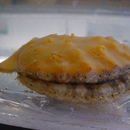fi
nimet breadcrumb-navigoinnissa


Myxilla incrustans is 'n sponsspesie in die taksonomiese indeling van die Demospongiae (gewone sponse). Die liggaam van die spons bestaan uit kieselnaalde en sponginevesels en is in staat om baie water op te neem.
Die spons behoort tot die genus Myxilla en tot die familie Myxillidae. Die wetenskaplike naam van die spesie is die eerste keer geldig gepubliseer in 1842 deur Johnston.
Myxilla incrustans is 'n sponsspesie in die taksonomiese indeling van die Demospongiae (gewone sponse). Die liggaam van die spons bestaan uit kieselnaalde en sponginevesels en is in staat om baie water op te neem.
Die spons behoort tot die genus Myxilla en tot die familie Myxillidae. Die wetenskaplike naam van die spesie is die eerste keer geldig gepubliseer in 1842 deur Johnston.
Myxilla incrustans is a species of demosponge. It is an encrusting species and is usually yellow.
M. incrustans is an encrusting sponge occurring in patches up to 20 cm (8 in) across and 5 cm (2 in) high. It is usually some shade of yellow but can range through orange, pink and white. It has a bubbly-looking appearance with internal channels visible through the surface and large, raised oscules. The consistency is fairly soft and elastic but the surface feels crisp because of the vertical spicule bundles supporting it. The skeleton is built out of tornotes, megascleres with spear-shaped ends with tiny spines on them. The microscleres are a mixture of curved, shovel-like chelae and "C"-shaped sigmas. Several other similar sponges grow in the same habitats and microscopic examination is necessary to identify the species.[3]
M. incrustans was described from specimens collected in the Firth of Forth, Scotland, North Sea. It is reported from the Arctic, round Bear Island and the Faroe Islands, on the coasts of Norway and south along the Atlantic coast to the Mediterranean Sea. In these areas, it is usually found between low-water mark and a depth of 400 metres (1,300 ft) on vertical rocks and sites with clean water exposed to strong tidal flows.[3] It also occurs in the north Pacific Ocean from Japan to California, where it is often found growing on the shells of scallops in the genus Chlamys.[4][5][6] It is unclear whether the free living Atlantic sponges and the Mutualistic pacific sponges are the same species.
M. incrustans is viviparous and in the months of August and September, developing embryos are sometimes found inside the tissues. These are spherical and measure about 0.5 mm (0.020 in) across before becoming detached.[3] Initiation of the sexual processes involved in reproduction depends on the water temperature. The male tissue releases sperm into the water column. These may get sucked into another sponge, and then fertilisation takes place. About 7% to 12% of the maternal tissue of the sponge is used up in the reproductive process, and there is some localized destruction of the tissue.[7]
Myxilla incrustans is a species of demosponge. It is an encrusting species and is usually yellow.
Myxille encroûtante (Myxilla incrustans) est une espèce d'éponge de la famille des Myxillidés.
C'est une espèce commune en Mer blanche à des profondeurs de 15 à 25 mètres[1]
Elle a été estimée à 4 ans environ[1].
L'espèce est vivipare. La reproduction est déclenchée par les variations de température de l'eau.
La contribution du métabolisme de l'éponge à son effort de reproduction semble relativement faible (par rapport à d'autres espèces) ; seulement 7,3 % de la masse tissulaire de l'éponge contribue à la reproduction (à comparer à d'autres espèces d'éponges vivant dans le même milieu comme Halisarca dujardini (Halisaalrcida) ou Iophon piceus (Poecilosclerida) qui consacrent respectivement 12 et 69 % de leurs tissus à la reproduction[1]. Dans les eaux froides où elle est présente elle fait partie du groupe (les éponges de mer) qui dominent la communauté benthique (ex : en Mer de Barent, les éponges constituent 54 % de la biomasse totale[2]).
Myxille encroûtante (Myxilla incrustans) est une espèce d'éponge de la famille des Myxillidés.
C'est une espèce commune en Mer blanche à des profondeurs de 15 à 25 mètres
Myxilla (Myxilla) incrustans adalah spesies spons yang tergolong dalam kelas Demospongiae. Spesies ini juga merupakan bagian dari kelas Demospongiae, filum Porifera, subregnum Parazoa, dan kingdom Animalia.
Seperti spons pada umumnya, spesies ini memiliki tubuh yang berpori dan permukaan yang keras seperti batu. Selain itu, Myxilla (Myxilla) incrustans juga dapat menyerap oksigen dari air melalui proses difusi.
Myxilla (Myxilla) incrustans adalah spesies spons yang tergolong dalam kelas Demospongiae. Spesies ini juga merupakan bagian dari kelas Demospongiae, filum Porifera, subregnum Parazoa, dan kingdom Animalia.
Seperti spons pada umumnya, spesies ini memiliki tubuh yang berpori dan permukaan yang keras seperti batu. Selain itu, Myxilla (Myxilla) incrustans juga dapat menyerap oksigen dari air melalui proses difusi.
Myxilla (Myxilla) incrustans is een sponssoort in de taxonomische indeling van de gewone sponzen (Demospongiae). Het lichaam van de spons bestaat uit kiezelnaalden en sponginevezels, en is in staat om veel water op te nemen.
De spons behoort tot het geslacht Myxilla en behoort tot de familie Myxillidae. De wetenschappelijke naam van de soort werd voor het eerst geldig gepubliceerd in 1842 door Johnston.
Bronnen, noten en/of referenties